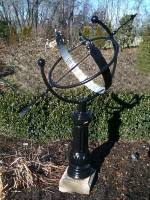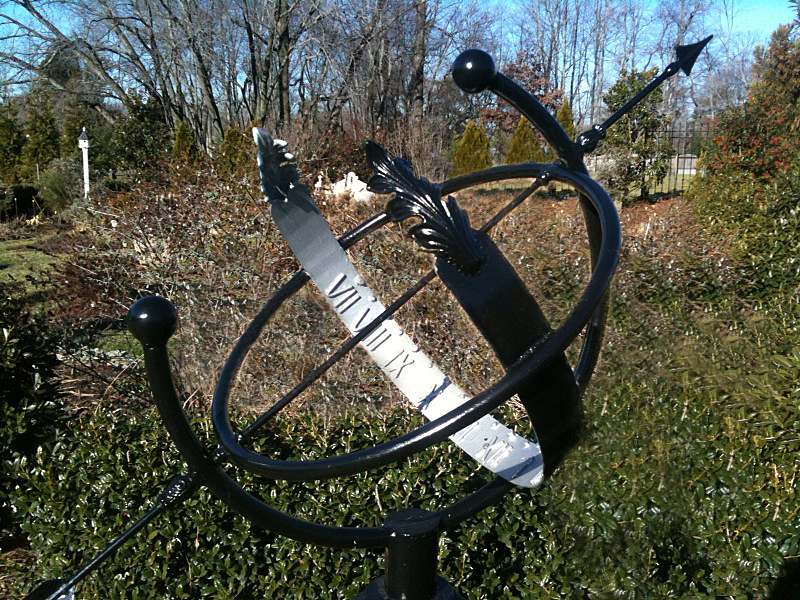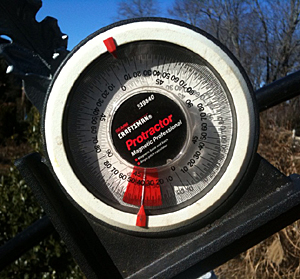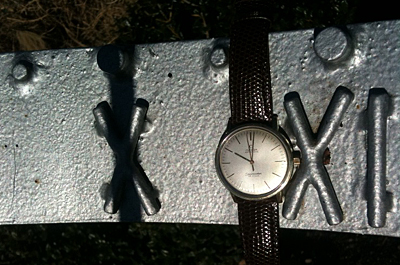 Many people think of sundials in the garden as nothing more than decorations or historical curiosities. However, sundials can be a great addition to your garden. They can be beautiful focal points like an urn or garden sculpture, but in addition they are scientific instruments that show accurate time while providing a special mood or setting to the garden. Last year we planted the iris beds in the garden room we call the Pool Garden. It’s a special place that’s off the beaten path and with the noise of the water is a spot that just says “slow down”. So the head gardener did some research on sundials and constructed one for the Pool Garden.
Many people think of sundials in the garden as nothing more than decorations or historical curiosities. However, sundials can be a great addition to your garden. They can be beautiful focal points like an urn or garden sculpture, but in addition they are scientific instruments that show accurate time while providing a special mood or setting to the garden. Last year we planted the iris beds in the garden room we call the Pool Garden. It’s a special place that’s off the beaten path and with the noise of the water is a spot that just says “slow down”. So the head gardener did some research on sundials and constructed one for the Pool Garden.
 Our sundial contains attributes of both armillary and equatorial bow sundials. The traditional armillary sphere has bands or rings positioned to represent the equator, prime meridian, and other celestial circles of the globe. Ours is made of hoops, but they are open (like an equatorial bow sundial) so they don’t cast shadows that would interfere with reading the time. It’s made of iron rod, pipe, and plate, uses the bottom of a cast iron light pole as the base, and is 5′ 10″ tall. It has the special feature of being able to adjust for Eastern Standard Time, Eastern Daylight Time, or sun time at its exact location by rotating the numbered dial surface without changing the gnomon position or orientation.
Our sundial contains attributes of both armillary and equatorial bow sundials. The traditional armillary sphere has bands or rings positioned to represent the equator, prime meridian, and other celestial circles of the globe. Ours is made of hoops, but they are open (like an equatorial bow sundial) so they don’t cast shadows that would interfere with reading the time. It’s made of iron rod, pipe, and plate, uses the bottom of a cast iron light pole as the base, and is 5′ 10″ tall. It has the special feature of being able to adjust for Eastern Standard Time, Eastern Daylight Time, or sun time at its exact location by rotating the numbered dial surface without changing the gnomon position or orientation.
Whether you build your own armillary sundial as we have, or purchase one, there are a some essential points you must follow when installing it or it will not show accurate time. But first a word of caution; to work properly a sundial should be made specifically for the location where it is going to be used. The traditional mass-produced horizontal sundials sold at garden centers are really just garden ornaments and are not functional. However, many of the garden center quality armillary sundials can be adapted to your location if you follow these installation instructions.
 Choose your location carefully. The longer your sundial is in direct sunlight, the greater part of the day it will give accurate readings.
Choose your location carefully. The longer your sundial is in direct sunlight, the greater part of the day it will give accurate readings.
 Position the base of the sundial and level it carefully. Be sure the base is securely attached to the ground and will not move because of ground settlement, frost heaving, or anything else. Any change in the position of the base will effect the accuracy of the sundial.
Position the base of the sundial and level it carefully. Be sure the base is securely attached to the ground and will not move because of ground settlement, frost heaving, or anything else. Any change in the position of the base will effect the accuracy of the sundial.

 An armillary sundial works on the same principle as a conventional flat sundial but with the hours engraved on a curved hour band. As the sun travels across the sky the arrow, or gnomon, casts its shadow on the hour band. The accuracy of your sundial is determined by the angle of the gnomon so proper set-up is crucial. The angle on the gnomon has to be parallel to the earth’s axis so as not to require adjustment for the changing “height” of the sun in the sky during different seasons. Thus the angle of the gnomon must be equal to your latitude when measured with a horizontal or level surface. If your dial was mass produced and the gnomon is not at the angle of your latitude you will have to tilt your entire dial on the base so the angle of the gnomon is equal to your latitude. You can find your exact latitude at the U.S. Department of Commerce, NOAA Solar Calculator web site.
An armillary sundial works on the same principle as a conventional flat sundial but with the hours engraved on a curved hour band. As the sun travels across the sky the arrow, or gnomon, casts its shadow on the hour band. The accuracy of your sundial is determined by the angle of the gnomon so proper set-up is crucial. The angle on the gnomon has to be parallel to the earth’s axis so as not to require adjustment for the changing “height” of the sun in the sky during different seasons. Thus the angle of the gnomon must be equal to your latitude when measured with a horizontal or level surface. If your dial was mass produced and the gnomon is not at the angle of your latitude you will have to tilt your entire dial on the base so the angle of the gnomon is equal to your latitude. You can find your exact latitude at the U.S. Department of Commerce, NOAA Solar Calculator web site.
 The gnomon must point towards the true north (parallel with the earths axis), not the north magnetic pole that you locate with a compass. In the northern hemisphere, this means the gnomon should point at the North Pole Star. There are several methods of finding the true north direction, but an easy way is to mark a shadow cast by a true vertical object at the exact time of your solar noon. You can use a plumb line suspended from a tripod or a thin pole aligned vertically with a spirit level to cast the shadow. The time of Solar Noon for your location can be found at the U.S. Department of Commerce, NOAA Solar Calculator web site. Once you have marked the shadow at the instant of local noon, position the gnomon parallel to it and it will be pointed true north. Be sure to keep the east-west sides of the dial level and attach your sundial to its base.
The gnomon must point towards the true north (parallel with the earths axis), not the north magnetic pole that you locate with a compass. In the northern hemisphere, this means the gnomon should point at the North Pole Star. There are several methods of finding the true north direction, but an easy way is to mark a shadow cast by a true vertical object at the exact time of your solar noon. You can use a plumb line suspended from a tripod or a thin pole aligned vertically with a spirit level to cast the shadow. The time of Solar Noon for your location can be found at the U.S. Department of Commerce, NOAA Solar Calculator web site. Once you have marked the shadow at the instant of local noon, position the gnomon parallel to it and it will be pointed true north. Be sure to keep the east-west sides of the dial level and attach your sundial to its base.
 Your sundial will obviously be one hour off during daylight saving time in the summer, when clocks are reset from standard time.
Your sundial will obviously be one hour off during daylight saving time in the summer, when clocks are reset from standard time.
 In order to standardize timekeeping, 24 time zones were created by dividing the earth’s 360o circumference into 24 one hour segments, each zone being 15o of longitude wide and the time within each zone being that of its central meridian. (Click here to find your central meridian.) To compensate for the distance of your sundial location east or west of the central meridian of your time zone you will need to apply a correction of 4 minutes of time per degree. For example, since the sun moves from east to west, if your sundial is located 3o west of your time zone central meridian its time will read 12 minutes slow. Since this is a constant correction throughout the year it can be included when constructing the dial by rotating the numbered surface by an angle equaling the difference in longitude, without changing the gnomon position or orientation. If you have a purchased dial you need to subtract or add the suns travel time to the central meridian.
In order to standardize timekeeping, 24 time zones were created by dividing the earth’s 360o circumference into 24 one hour segments, each zone being 15o of longitude wide and the time within each zone being that of its central meridian. (Click here to find your central meridian.) To compensate for the distance of your sundial location east or west of the central meridian of your time zone you will need to apply a correction of 4 minutes of time per degree. For example, since the sun moves from east to west, if your sundial is located 3o west of your time zone central meridian its time will read 12 minutes slow. Since this is a constant correction throughout the year it can be included when constructing the dial by rotating the numbered surface by an angle equaling the difference in longitude, without changing the gnomon position or orientation. If you have a purchased dial you need to subtract or add the suns travel time to the central meridian.

 Finally, a small periodic variation exists called the “equation of time”. This variation can only be built into complex sundials, thus it will need to be mentally “corrected” to achieve accurate clock time. This variation from clock time changes each day of the year causing the sundial’s time to appear to be “fast” by as much as 16 minutes or “slow” by as much as 14 minutes throughout the year. This variation is caused by the earth’s elliptical orbit, and the 23.44° tilt of its axis from the plane of its orbit. The simple method to compensate for the equation of time variation is to use a table that shows the amount your dial will vary from clock time through the year. (Click here for a copy of the Equation of Time table) This correction is universal and it does not change with the local latitude or longitude of the sundial.
Finally, a small periodic variation exists called the “equation of time”. This variation can only be built into complex sundials, thus it will need to be mentally “corrected” to achieve accurate clock time. This variation from clock time changes each day of the year causing the sundial’s time to appear to be “fast” by as much as 16 minutes or “slow” by as much as 14 minutes throughout the year. This variation is caused by the earth’s elliptical orbit, and the 23.44° tilt of its axis from the plane of its orbit. The simple method to compensate for the equation of time variation is to use a table that shows the amount your dial will vary from clock time through the year. (Click here for a copy of the Equation of Time table) This correction is universal and it does not change with the local latitude or longitude of the sundial.
At first this installation process may appear complicated and not worth the effort. However, we can say having our sundial in the pool garden has added far more then we expected and we find ourselves drawn to check the time telling shadow on the dial face when ever were in that area of the garden. It is the focal point of the garden and a unique piece of sculpture that draws everyone closer to read the time with great amazement because it is so accurate. Everyone, young and old, likes to read the time on a sundial.
If you would like to learn more about sundials you can purchase excellent books from Amazon.com. I suggest, Sundials: Their Theory and Construction by Albert E. Waugh; and Sundials: Their Construction and Use by R. Newton Mayall and Margaret W. Mayall. Both books are rich in practical information and theory, and are essential for anyone interested in understanding or building a sundial. The Albert Waugh book, although technical and in-depth, is a great source to begin your quest for sundial information.